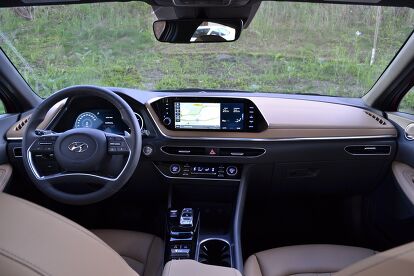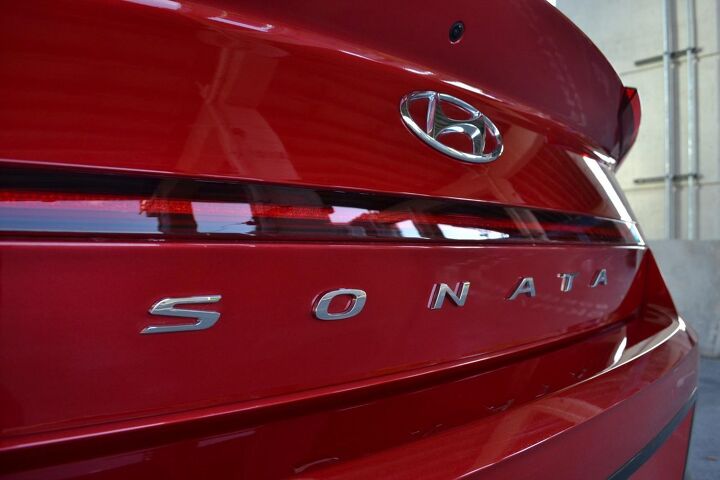2020 Hyundai Sonata Review

Consider the evolution of the common sedan.
With the market so thoroughly embracing crossovers, the once-loved sedan segment is much smaller now. Instead of taking the defeat lying down, many models have adopted more dramatic looks and more premium interiors. What was once the default is now a considered choice—a move against the grain.
Nowhere is that more apparent than in the new-for-2020 Hyundai Sonata. The Korean automaker has taken what was a fine, if unremarkable, four-door and given it an eye-catching makeover. What’s more, it’s loaded the car with tech and yet kept the brand’s tradition of value, turning the Sonata into one of the most impressive cars in its class.
Let’s talk about those looks
FAST FACTS
| Engine: | 1.6L I4 Turbo |
| Output: | 180 hp, 195 lb-ft |
| Transmission: | 8AT |
| US Fuel Economy (mpg, city/highway/combined): | 27/36/31 |
| CAN Fuel Economy (L/100 km, city/highway/combined): | 8.6/6.6/7.7 |
| Starting Price (USD): | $24,575 (inc. dest) |
| As-Tested Price (USD): | $34,475 ( inc. dest.) |
| Starting Price (CAD): | $28,809 (inc. dest.) |
| As-Tested Price (CAD): | $40,609 (inc. dest.) |
We’ve already had over a year to let the new Sonata’s exterior styling sink in. Time has not dulled these lines; especially in this deep shade of red, the eighth-gen sedan remains a jolt to the system. Whether you like it or not, there’s no arguing it’s distinctive. The Sonata’s main party trick is the light-up chrome running up from the inner edges of the headlights. It’s a fun bit of feel-good theater to see in action, and it makes the car easy to place at night. The taillight treatment, with the thin light strip connecting the elements and the little vortex generators, is similarly ogle-worthy.
SEE ALSO: Toyota Camry vs Hyundai Sonata Spec ComparisonThe details are well-resolved, but there are angles that are less flattering. That wide-mouth grille does the Sonata little favors when viewed head-on, for example. Back up a bit and clock its front three-quarter and the way the hood shut lines extend right into the grille gives it a low-nosed, early-aughts Aston Martin vibe. Back up further still and move to the side for proportions that are on-point, with the Audi A7-like shape visually shrinking the Sonata.
Spacious and stylish interior
Luckily that stylish roofline doesn’t translate to a literal lack of space inside. There’s ample space in both rows here, more than enough for average adults, even with the panoramic sunroof found in my tester. By the numbers the Sonata boasts four extra inches of front legroom than the Toyota Camry and Honda Accord (at a hair over 46 inches). The Korean car loses out by nearly the same amount to the Camry in the second row however: 34.8 versus 38.0 inches. Stretching further still is the Accord, at a full 40.4 inches of rear-row dancehall space.
The Sonata’s interior looks a step above either of its Japanese competitors however. My loaded tester comes with a two-tone camel/gray leather-trimmed interior that wouldn’t have felt out of place in the Genesis G70 I drove recently. It’s logically laid out, with all the important controls falling easily to hand. It all feels good to the touch as well: the leather seats are just the right mix of supportive and comforting. The seating position in general is quite good, with a clear view out of the Sonata, though the thick A-pillars do require a bit of chicken-necking at intersections. And I’m still not sure of that steering wheel design.
Loaded with tech
Top-shelf Sonata trims arrive with both the 10.25-inch infotainment screen and a 12.3-inch item for the gauge cluster. The central screen is a solid example of modern infotainment systems: it’s easy to learn, and its configurability means you can tailor it to your needs, minimizing the need to fiddle with what’s displaying when on the move. Meanwhile the digital gauge cluster replaces one of the gauges with the view from a blind-spot camera whenever you signal. It’s one of those clever features you’re surprised isn’t more common, feeling like a natural progression for digital clusters and not just tech for tech’s sake.
Speaking of, for all its funny, Super Bowl ad time, Smart Park is more of a future stepping stone than a killer app. It works without issue, and will apply the brakes if something is in the car’s path. But realistically, you’re not going to use it in a crowded supermarket parking lot. If the spot is too tight for you to do the deed yourself, then slotting the car in with Smart Park is asking for a door ding from the cars on either side. It could be very useful for those with tight garage spaces though.
Every 2020 Sonata features emergency braking, adaptive cruise control, lane-keep assist and a driver attention warning. Blind-spot monitoring and rear cross-traffic alert show up on the SEL onwards, while Highway Drive Assist (HDA) is optional on the SEL Plus and standard on the Limited. HDA keeps the Sonata in its lane on the highway, though in my experience it isn’t vigilant enough with ensuring the driver’s hands are on the wheel.
During my time with the Sonata, its front proximity sensors threw up a few false positives. It was always in traffic at a light, and never stopped the car from taking off, but the beeping and cut radio volume would get tiresome. I checked the front sensors and found nothing unusual.
A sense of calm on the road
Phantom obstacles aside, the Sonata was a bubble of calm every time I took it out for a drive. The front wheels respond to inputs from the steering wheel with accuracy, and the suspension soaks up rutted post-winter roads without much noise or judders finding their way into the cabin. While the sedan feels stiff and relatively light, this isn’t a sporty car—that’s what the upcoming Sonata N-Line is for.
The Sonata’s current two-engine lineup is markedly different from the norm. Lower trims use a naturally-aspirated, 2.5-liter four cylinder, with 191 hp and 181 lb-ft of torque. That’s not far off the base engines in the Camry and Accord. My tester runs the Hyundai 1.6-liter turbocharged four-pot however, and this higher-spec engine produces… 180 hp and 195 lb-ft. Yes, it makes do with less horsepower than the base engine. Both engines hook up to an eight-speed automatic.
The engine lineup, and the lack of available all-wheel drive—which Hyundai has said can fit the platform—might turn some buyers off. After all, we live in a world where the Camry produces over 300 hp. Counterpoint: historically the big-engined Camcords of previous generations have been only a small percentage of overall sales. Even Toyota’s own forecast calls for around 15 percent of 2020 Camry production to be the all-paw model. Northern markets will likely be more concerned about the lack of AWD, but as ever, a good set of winter tires should be enough foul weather security for most people.
I was never left wanting for more power in the Sonata, as the quick-shifting auto and torquey turbo engine got it up to highway speeds without issue. I ended my time with the Sonata hovering right around 30 mpg. I was able to beat the quoted 36 mpg highway rating—if only just. With an EPA rating of 31 mpg combined, the Sonata matches the I4 Camry and loses out to the 1.5-liter Accord by 2 mpg.
Verdict: 2020 Hyundai Sonata Review
The 2020 Sonata is a three-pronged attack on the staid sedan segment. Two of these are new: a beguiling sense of style inside and out, and a big focus on tech. The other is the long-standing value reputation Hyundai is known for. With all the bells and whistles the Limited lists for $34,475 including destination; my Canuck-spec Ultimate trim goes for $40,609 north of the border. That undercuts both its main rivals as well as the turbocharged version of the Subaru Legacy.
It may not be able to match the power outputs of the rest of the class, but as a whole, the Sonata is a deeply impressive ride. If you’re in the market for a mid-30k vehicle—sedan or not—make sure the Sonata is on your short list.
LOVE IT
- Standout looks
- High-tech interior
- Smooth ride
LEAVE IT
- Those standout looks
- Lacks more powerful engine options
- No all-wheel drive

Kyle began his automotive obsession before he even started school, courtesy of a remote control Porsche and various LEGO sets. He later studied advertising and graphic design at Humber College, which led him to writing about cars (both real and digital). He is now a proud member of the Automobile Journalists Association of Canada (AJAC), where he was the Journalist of the Year runner-up for 2021.
More by Kyle Patrick

































































Comments
Join the conversation